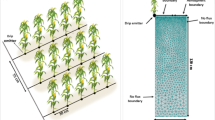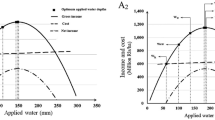Abstract
This paper develops and applies a dynamic mathematical model for optimal scheduling of nitrogen fertilization and irrigation that minimizes nitrogen leaching subject to a target level of yield. The analysis assumes a single crop grown during a single growing season of a given length. It is shown that substitution of water for nitrogen along a given plant growth path decreases nitrogen leaching and, therefore, groundwater contamination. It is proved that a minimum leaching solution to the optimization problem is obtained with a single nitrogen application at the beginning of the season and irrigation scheduling that maintains a wet soil throughout the growing period. A numerical example utilizing experimental data for an irrigated summer corn in Israel confirms and quantifies the analytical findings.
Similar content being viewed by others
Literature
Feigin, A., H. Bielorai, Y. Day, M. Giskin and T. Kipnis. 1978. The nitrogen factor in the management of effluent-irrigated soils.Soil Sci. 125, 248–254.
Hadas, A., B. Bar-Yosef, U. Kafkafi and J. Yaniv. 1979.A Model to Determine N, P, KFertilization: Recommendation Under Field Conditions. Division of Scientific Publications, Volcani Center, Bet Dagan, Israel, Pamphlet No. 217.
Iwasa, Y. and J. Roughgarden. 1983. Shoot/root balance of plants: optimal growth of a system with many vegetative organs.Theor. Population Biol. 25, 78–105.
Kafkafi, U. and B. Bar Yosef. 1971. Long-term effects of cumulative application of fertilizers on irrigated soils and crops. Final Report to Ford Foundation, Project A-III, The Volcani Institute of Agricultural Research, Bet-Dagan, Israel.
Keeney, D. R. 1982. Nitrogen management for maximum efficiency and minimum pollution. InNitrogen in Agricultural Soils, F. J. Stevenson (Ed.), Agronomy Monograph No. 22. Madison, WI: American Society of Agronomy.
King, D. and J. Roughgarden. 1982. Graded allocation between vegetative and reproductive growth for annual plants in growing seasons of random length.Theor. Population Biol. 22, 1–16.
Knisel, W. G. 1980. CREAMS, a field scale model for chemicals, runoff and erosion from agricultural management systems. U.S. Dept. Agric. Conserv., Res. Rep. No. 26.
Letey, J., J. M. Blair, D. Devitt, L. J. Lund and P. Nash. 1977. Nitrate-nitrogen in effluent from agricultural tile drains in California.Hilgardia 45, 289–319.
Maddala, G. S. 1977.Econometrics. New York: McGraw-Hill.
Nielsen, E. B. and L. K. Lee. 1987. The magnitude and costs of groundwater contamination from agricultural chemicals. USDA, Economic Research Service, Res. and Tech. Division, Agricultural Econ. Report No. 576.
Power, J. F. 1987. Legumes: their potential role in agricultural production.Am. J. Alternative Agric. 2, 69–73.
Pratt, P. F. and W. A. Jury. 1984. Pollution of the standard zone with nitrate. InBehavior of Pollutants in the Unsaturated Zones, B. Yaron, G. Dagan and J. Goldshmit (Eds), pp. 53–67. Berlin: Springer.
Roughgarden, J. 1986. Models of population processes for plants. Some mathematical questions in biology. Plant biology,Lectures Math. Life Sci. 18, 235–267.
Seligman, N. G. and H. Van Keulen, 1981. PAPRAN: a simulation model of annual pasture production limited by rainfall and nitrogen. InSimulation of Nitrogen Behavior of Soil-Plant, M. J. Frissel and J. A. Van Veen (Eds), Proc. Workshop, Wageningen.
Thornley, H. M. and I. R. Johnson. 1986. Modelling plant processes and crop growth. Some mathematical questions in biology. Plant biology.Lectures Math. Life Sci. 18, 84–133.
Williams, J. R., K. G. Renard and P. T. Dyke. 1983. A new method for assessing the effect of erosion on productivity—the EPIC model.J. Soil Water Conserv. 38, 981–983.
Author information
Authors and Affiliations
Rights and permissions
About this article
Cite this article
Falkovitz, M.S., Feinerman, E. Minimum leaching scheduling of nitrogen fertilization and irrigation. Bltn Mathcal Biology 56, 665–686 (1994). https://doi.org/10.1007/BF02460716
Received:
Revised:
Issue Date:
DOI: https://doi.org/10.1007/BF02460716




